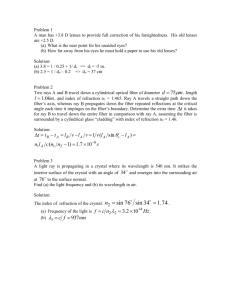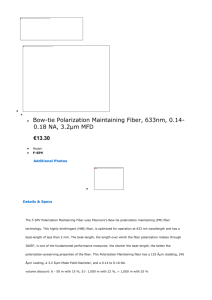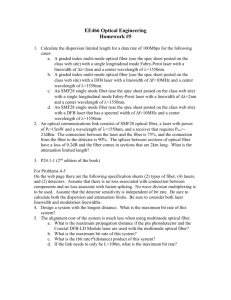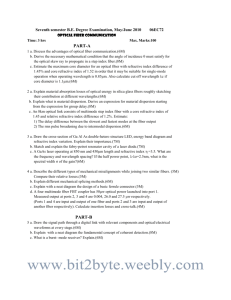Examination S-108.3110 15.1.2010 No study materials are allowed
advertisement
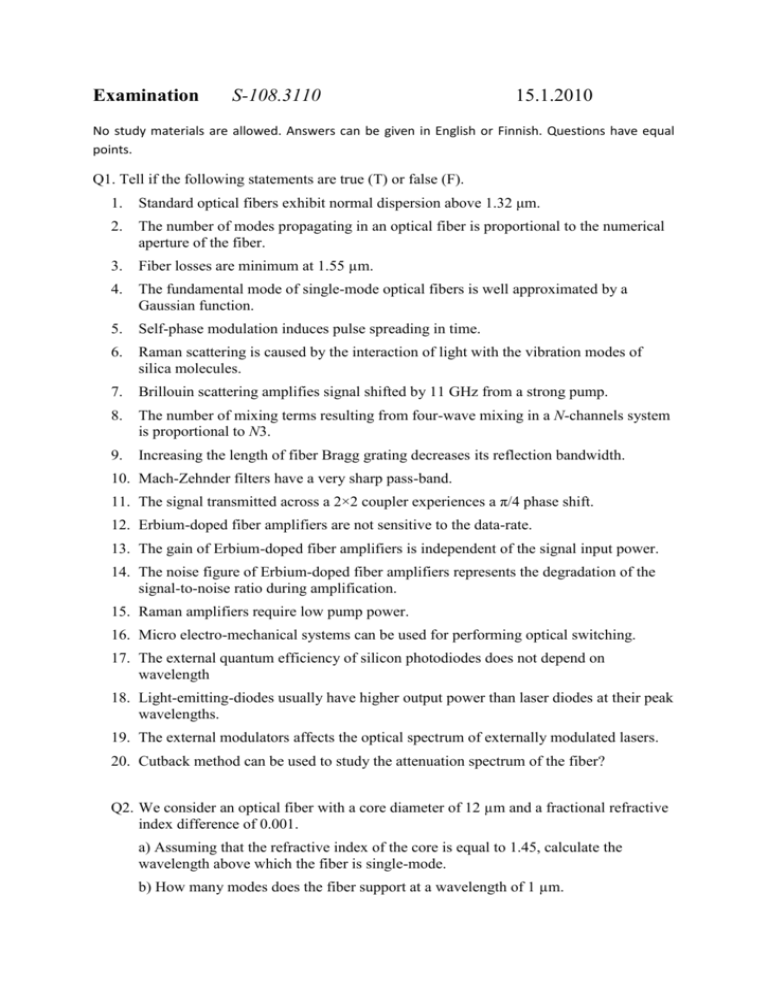
Examination S-108.3110 15.1.2010 No study materials are allowed. Answers can be given in English or Finnish. Questions have equal points. Q1. Tell if the following statements are true (T) or false (F). 1. Standard optical fibers exhibit normal dispersion above 1.32 μm. 2. The number of modes propagating in an optical fiber is proportional to the numerical aperture of the fiber. 3. Fiber losses are minimum at 1.55 µm. 4. The fundamental mode of single-mode optical fibers is well approximated by a Gaussian function. 5. Self-phase modulation induces pulse spreading in time. 6. Raman scattering is caused by the interaction of light with the vibration modes of silica molecules. 7. Brillouin scattering amplifies signal shifted by 11 GHz from a strong pump. 8. The number of mixing terms resulting from four-wave mixing in a N-channels system is proportional to N3. 9. Increasing the length of fiber Bragg grating decreases its reflection bandwidth. 10. Mach-Zehnder filters have a very sharp pass-band. 11. The signal transmitted across a 2×2 coupler experiences a π/4 phase shift. 12. Erbium-doped fiber amplifiers are not sensitive to the data-rate. 13. The gain of Erbium-doped fiber amplifiers is independent of the signal input power. 14. The noise figure of Erbium-doped fiber amplifiers represents the degradation of the signal-to-noise ratio during amplification. 15. Raman amplifiers require low pump power. 16. Micro electro-mechanical systems can be used for performing optical switching. 17. The external quantum efficiency of silicon photodiodes does not depend on wavelength 18. Light-emitting-diodes usually have higher output power than laser diodes at their peak wavelengths. 19. The external modulators affects the optical spectrum of externally modulated lasers. 20. Cutback method can be used to study the attenuation spectrum of the fiber? Q2. We consider an optical fiber with a core diameter of 12 µm and a fractional refractive index difference of 0.001. a) Assuming that the refractive index of the core is equal to 1.45, calculate the wavelength above which the fiber is single-mode. b) How many modes does the fiber support at a wavelength of 1 µm. c) Calculate the propagation distance over which the injected optical power Pin is reduced by a factor of 4 if the fiber has an attenuation coefficient of 0.6 dB/km. Q3. Consider two different optical fiber links. a) The link number 1 consists of a multimode-fiber that transmits data at a wavelength of 0.8 μm with a rate of 20 Mb/s. At this wavelength, the multimode fiber attenuation is 1 dB/km. The fractional refractive index difference of the fiber is 0.01 and the core refractive index is 1.5. Calculate the inter-modal dispersion of the fiber. Deduce the maximum possible length for the link. Assuming a transmitter with an output power POut =0.5 dBm, calculate the minimum sensitivity of the detector. b) The link number 2 consists of a single-mode fiber that transmits data at a wavelength of 1.55 μm with a rate of 1 Gb/s. At this wavelength, the fiber attenuation is 0.5 dB/km and the fiber intra-modal dispersion is 17 ps/nm×km. The spectral width of the transmitter is Δλ=1 nm and the transmitter output power is POut =1 mW. Assuming that the detector sensitivity is equal to -30 dBm what is the maximum possible length for this link? Q4. Consider the following component consisting of two 50/50 couplers connected together with a delay line inserted in-between as shown below. The delay line consists of a fiber of length L and effective refractive index neff = 1.5. The wavelength of the light propagating in the component is = 1550 nm. L POUT1 P1 50/50 L P2 50/50 L POUT2 a) Calculate POUT1 and POUT2 as a function of P1 and P2. Calculate the length L of the fiber to obtain the following outputs: b) POUT1=P1 and POUT2=P2 c) POUT1=P2 and POUT2=P1 d) POUT1= POUT2=1/2×(P1+P2) Q5. The responsivity of a photodiode is defined as the ratio of output photocurrent (in Amperes unit) to the incident optical power (in Watts unit). a) Calculate the responsivity of the photodiode with an external quantum efficiency of 80% at the wavelength of 1500 nm. b) What is the responsivity when the active material thickness is 250 μm and the absorption coefficient is 4 mm-1? c) Determine the wavelength range at which a InGaAs can operate. Why? Q6. Explain briefly a) What is the threshold current of a semiconductor laser b) Advantages and disadvantages of using 1480 nm over 980 nm as the wavelength of EDFAs’ pumping source. c) Two mechanisms commonly employed in achieving single-longitudinal mode operation of diode lasers.




